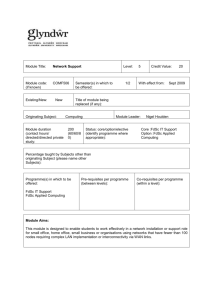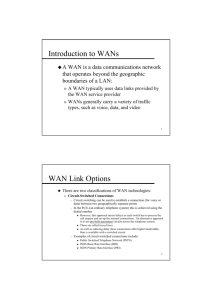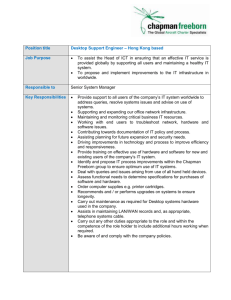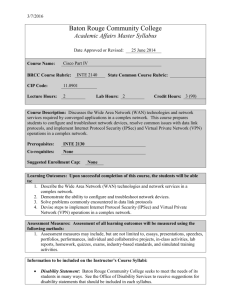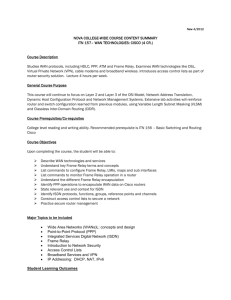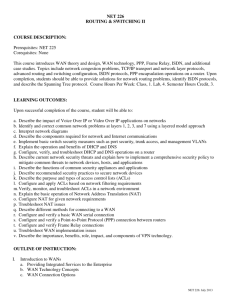Threaded Case Study
advertisement
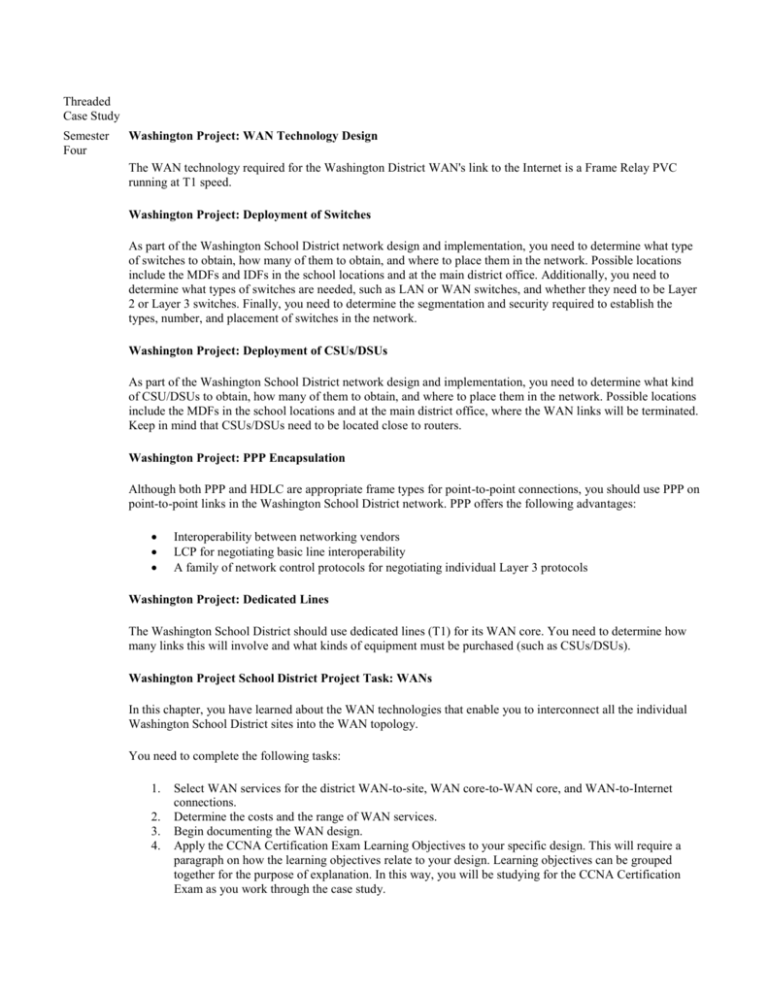
Threaded Case Study Semester Four Washington Project: WAN Technology Design The WAN technology required for the Washington District WAN's link to the Internet is a Frame Relay PVC running at T1 speed. Washington Project: Deployment of Switches As part of the Washington School District network design and implementation, you need to determine what type of switches to obtain, how many of them to obtain, and where to place them in the network. Possible locations include the MDFs and IDFs in the school locations and at the main district office. Additionally, you need to determine what types of switches are needed, such as LAN or WAN switches, and whether they need to be Layer 2 or Layer 3 switches. Finally, you need to determine the segmentation and security required to establish the types, number, and placement of switches in the network. Washington Project: Deployment of CSUs/DSUs As part of the Washington School District network design and implementation, you need to determine what kind of CSU/DSUs to obtain, how many of them to obtain, and where to place them in the network. Possible locations include the MDFs in the school locations and at the main district office, where the WAN links will be terminated. Keep in mind that CSUs/DSUs need to be located close to routers. Washington Project: PPP Encapsulation Although both PPP and HDLC are appropriate frame types for point-to-point connections, you should use PPP on point-to-point links in the Washington School District network. PPP offers the following advantages: Interoperability between networking vendors LCP for negotiating basic line interoperability A family of network control protocols for negotiating individual Layer 3 protocols Washington Project: Dedicated Lines The Washington School District should use dedicated lines (T1) for its WAN core. You need to determine how many links this will involve and what kinds of equipment must be purchased (such as CSUs/DSUs). Washington Project School District Project Task: WANs In this chapter, you have learned about the WAN technologies that enable you to interconnect all the individual Washington School District sites into the WAN topology. You need to complete the following tasks: 1. 2. 3. 4. Select WAN services for the district WAN-to-site, WAN core-to-WAN core, and WAN-to-Internet connections. Determine the costs and the range of WAN services. Begin documenting the WAN design. Apply the CCNA Certification Exam Learning Objectives to your specific design. This will require a paragraph on how the learning objectives relate to your design. Learning objectives can be grouped together for the purpose of explanation. In this way, you will be studying for the CCNA Certification Exam as you work through the case study. 2 CCNA Certification Exam Learning Objectives (*** are explicit CCNA Exam objectives; unmarked are knowledge assumed by the exam): WANs Differentiate between the following WAN services: Frame Relay, ISDN/LAPD, HDLC, and PPP.*** Washington Project: Understanding the Customer First and foremost, you must understand your customers. In the case of the Washington School District, your customers include teachers, students, staff members, and administrators. You need to determine whether the district has documented policies in place. You need to answer questions like the following: Has district data been declared mission critical? Have district operations been declared mission critical? What protocols are allowed on the district network? Are only certain desktop hosts supported in the district? Mission-critical data and operations are considered key to the business. Access to them is critical for running the business on a daily basis. You need to determine who in the district has authority over mission-critical data and operations, along with addressing, naming, topology design, and configuration. Some districts have a central Management Information System (MIS) department that controls everything. Some districts have very small MIS departments so they must pass authority on to other departments and local school sites. Washington Project: Analyzing Availability You need to find out what availability means to your customers in the Washington School District. Your customers include teachers, students, administrators, and staff members. When analyzing your district's technical requirements, estimate the traffic load caused by applications and by normal protocol behavior (for example, a new node joining the network). Estimate worst-case traffic load during the busiest times for users and during regularly scheduled network services, such as file server backups. This will help you understand what availability means to your customers. Washington Project: Analyzing Network Traffic Load and Traffic Problems Before you develop a district network structure and select hardware, you need to determine the network traffic load that the district WAN needs to handle. You should determine all the sources of traffic and define what source characteristics must be ascertained. At this step, it is very important to define the sources in sufficient detail that source traffic can be measured or estimated. Additionally, you need to evaluate applications that might cause traffic problems in the Washington School District WAN. The following applications can generate large volumes of traffic and therefore can cause network problems such as congestion: Internet access Computers loading software from a remote site Anything that transmits images or video Central database access Department file servers 2 3 The introduction of new sources or applications into the Washington School District WAN must be projected, along with likely growth rates. Obviously, this step requires considerable consultation with district end users and application developers. Finally, district network management data is an important source that you should not overlook because it could take up more than 15% of the total traffic volume. Washington Project: The WAN Core The WAN core for the Washington School District network should be a high-speed backbone designed to route packets as quickly as possible. School locations should connect to the WAN core based on physical location. Washington Project: The Two-Layer Hierarchical Model The Washington School District WAN should be based on a two-layer hierarchical model. Three regional Hubs should be established in order to form a fast WAN core network. One hub should be placed at the District Office/Data Center, a second at the Service Center, and a third hub at Shaw Butte Elementary School. Washington Project: The Frame Relay Link You should provide access to the Internet or any other outside network connections through the Washington School District office by using a Frame Relay WAN link. For security purposes, no other connections should be permitted. Washington Project: WAN Design In this chapter you have learned about the WAN design process. Now you can focus on interconnecting all the individual Washington School District sites into a WAN topology that satisfies the users' requirements. Complete the following tasks: 1. 2. 3. 4. 5. Create a WAN design that includes the following: Create a WAN User Requirements Document focusing on interconnecting all of the individual school sites into a WAN topology. This topology should meet the needs suggested in the TCS Overview, your research, and your Instructor's assignments. Document WAN link speeds and upgrade paths Create a model of traffic flow between schools showing a two- or three-layer WAN hierarchy Develop a list of additional equipment, such as CSUs/DSUs (channel service units/data service units) and router interfaces required to implement the district-wide WAN Describe a list of what kind of redundancy is needed to ensure WAN uptime Summarize the benefits of your WAN design Each group should develop an overall WAN topology independent of each other and openly debate the merits of all of the designs. The outcome of this process will be a mutually agreed upon WAN design. Then apply this mutually agreed upon WAN design to your site (all sites). Document all the router commands necessary for reconfiguration of local site access routers in order to implement the WAN design. Document how a WAN implementation affects routing updates between routers. Apply the CCNA Certification Exam Learning Objectives to your specific design. This will require a paragraph on how the learning objectives relate to your design. Learning objectives can be grouped together for the purpose of explanation. In this way, you will be studying for their CCNA Certification Exam as you work through the case study. CCNA Certification Exam Learning Objectives 3 4 (*** are explicit CCNA Exam objectives; unmarked are knowledge assumed by the exam): General Describe the three major characteristics of a Wide Area Network Describe what a Regional Bell Operation Company (RBOC) is and what is its function OSI Model Describe which two layers of the OSI model WANs typically address Describe what a WAN data link protocol is and what is its function Describe the purpose of DTE and DCE devices and what layer of the OSI model do they apply to List four common data link layer WAN protocols WAN Describe what a Point of Presence (POP) and Central Office (CO) are and what is their function Describe how Time Division Multiplexing (TDM) works and what WAN technology uses it Describe what Customer Premise equipment is Describe the data encapsulation process across a WAN link Describe connection oriented and connectionless services across a WAN Describe how WAN signaling standards effect the throughput of WAN services Describe what a dedicated leased line is and how it is used Describe what packet switched connections are and what WAN services use this technology Describe what a hierarchical WAN design model is and what are the major benefits Describe the functions of each layer in a three layer hierarchical WAN model Describe why server placement and associated traffic patterns are important to understand when designing a WAN Washington Project: Applying PPP WAN design was covered and was used to develop Washington School District's WAN design. The design allowed connectivity between all sites in the district. Without a Layer 2 protocol, the physical WAN links have no mechanism to transmit data and implement flow control. In this chapter you will apply PPP as the data link-layer protocol to be used in the district WAN implementation. Washington Project: Enabling PPP Encapsulation You can enable PPP on serial lines to encapsulate IP and other network-layer protocol datagrams. To do so, enable PPP encapsulation in interface configuration mode, using the encapsulation ppp command: Step 1 Enter interface configuration mode for the desired interface. Step 2 Configure the interface for PPP encapsulation: Router(config-if)# encapsulation ppp 4 5 Washington School District Project Task: PPP In this chapter, you learned concepts and configuration processes that will help you configure PPP in the Washington School District network. As part of the configuration, you need to complete the following tasks: 1. 2. 3. 4. Apply PPP to the existing WAN designs and describe the effects. Document the router commands necessary to implement PPP on the router interfaces and how the router configuration changes. Describe the benefits of PPP as a Layer 2 WAN protocol versus other options. Apply the CCNA Certification Exam Learning Objectives to your specific design. This will require a paragraph on how the learning objectives relate to your design. Learning objectives can be grouped together for the purpose of explanation. In this way, you will be studying for your CCNA Certification Exam as you work through the case study. CCNA Certification Exam Learning Objectives (*** are explicit CCNA Exam objectives; unmarked are knowledge assumed by the exam): OSI Model Describe the OSI model layer(s) at which the Point-to-Point Protocol (PPP) operates and its function at those layers. Point to Point Protocol Describe what major types of WAN links are supported by PPP. Describe what the function of the Network Control Protocol (NCP) is within PPP. Describe what the function of the Link Control Protocol (LCP) is within PPP. Describe the functions of PAP and CHAP in a PPP implementation. Identify PPP operations to encapsulate WAN data on Cisco Routers*** Washington Project: ISDN Equipment and Media You need to identify what additional equipment and media will be necessary in order to implement an ISDN link in the Washington School District WAN design. Washington Project: ISDN Requirement A small remote site will require connectivity to the Washington School District WAN from time to time. You should use ISDN technology to make the small site a remote node on the WAN. Washington School District Project Task: ISDN In this chapter a new site will be brought into the network. This site is small and will only require connectivity from time to time. The decision has been made to connect it into the WAN core network using ISDN technology. As part of the ISDN configuration and implementation, you need to complete the following tasks: 1. 2. Describe how ISDN will be inserted in the WAN implementation, how data will be sent across the ISDN link, and the benefits of ISDN for a small site. Document the use of ISDN in the WAN design, including providing the following: 5 6 3. 4. A drawing of the implementation with all major reference points A description of overall bandwidth available to the site and how data communications will take place A description of all data communications equipment needed to accomplish the implementation Document the router commands needed to implement ISDN on the router and document the resulting changes in the local site access router configurations. Apply the CCNA Certification Exam Learning Objectives to your specific design. This will require a paragraph on how the learning objectives relate to your design. Learning objectives can be grouped together for the purpose of explanation. In this way, you will be studying for their CCNA Certification Exam as you work through the case study. CCNA Certification Exam Learning Objectives (*** are explicit CCNA Exam objectives; unmarked are knowledge assumed by the exam): General Describe the user requirement for implementing ISDN to a site Describe at what layer of a hierarchical WAN model an ISDN link should be installed OSI Model Define what three layers of the OSI model ISDN standards address. ISDN Describe the 3 data channels used in ISDN BRI and describe their functions Describe what ISDN protocols that start with "Q" address Describe what ISDN protocols that start with "I" address Describe what ISDN protocols that start with "E" address Describe the five major devices in a ISDN implementation Describe the four major reference points in an ISDN implementation Describe the function of Point to Point Protocol in an ISDN Implementation Describe why it is important to know the ISDN switch type when configuring an ISDN connection Describe the function of SPID numbers and why it is important when configuring and ISDN connection State a relevant use and context for ISDN networking*** Identify ISDN protocols, function groups, reference points, and channels*** Describe Cisco's implementation of ISDN BRI*** Washington School District Project Task: Frame Relay In this chapter, you have learned concepts and configuration processes that will help you implement a Frame Relay data link in the Washington School District network. You will design and implement the Frame Relay link to the Internet per the TCS Overview. This is the final step in the district network implementation. As part of the configuration and implementation, you need to complete the following tasks: 1. 2. 3. Describe how Frame Relay will be inserted in the WAN implementation, what speed will be required, and the benefits of Frame Relay. Document the insertion of Frame Relay in the WAN implementation, including: DLCI numbers The value of the CIR A description of all data communication equipment needed to accomplish implementation Document the router commands needed to implement Frame Relay on the firewall router and how the router configuration changes. 6 7 4. Apply the CCNA Certification Exam Learning Objectives to your specific design. This will require a paragraph on how the learning objectives relate to your design. Learning objectives can be grouped together for the purpose of explanation. In this way, you will be studying for the CCNA Certification Exam as you work through the case study. CCNA Certification Exam Learning Objectives (*** are explicit CCNA Exam objectives; unmarked are knowledge assumed by the exam): General Describe at what layer of a hierarchical WAN model an Frame Relay link should be installed OSI Model Describe what layers of the OSI model Frame Relay standards address and their functions at these layers. Frame Relay Describe DLCIs and their functions in a Frame Relay implementation. Describe LMIs and their function in a Frame Relay implementation. Describe a 'Permanent Virtual Circuit'. Describe connection-oriented network service and connectionless network service, and identify the key differences between them*** Describe 'Committed Information Rate' (CIR) and its function. Describe 'Forward Explicit Congestion Notification' (FECN) and its function. Describe 'Backward Explicit Congestion Notification' (BECN) and its function Describe 'Discard Eligibility' (DE) and its function. Recognize key Frame Relay terms and features*** List commands to configure Frame Relay LMIs, maps, and subinterfaces*** List commands to monitor Frame Relay operation in the router*** Washington School District Project Task: Finish the TCS In this chapter, you have learned about network management techniques that could help you run the individual school site LANs and the overall Washington School District WAN. You now need to complete all TCS LAN and WAN tasks from semesters 3 and 4. You should finish your Webbased portfolio solution to the TCS. You can use this as part of an "electronic resume" on a CD or a Web Site, to show your accomplishments. Be sure you have completed the following tasks: WAN Requirements Document WAN Physical Topology WAN Logical Topology, including IP Addressing Scheme WAN Electronics WAN Media PPP Implementation ISDN Implementation Frame Relay Implementation Traffic flow and Routing Update Analysis WAN Pros and Cons 7


